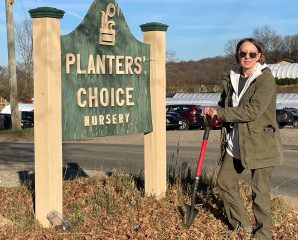My coworker, Elizabeth, and I have taken on the project of renovating and replanting the area around the Planters’ Choice sign on Huntingtown Road in Newtown. Being a plant nursery, we both agreed that there should be more plants and pizazz around the sign. Since we were new to the company as of last year, we were not around to see the planting bed as it was before the unfortunate incident of when a vehicle drove through it. As of the end of 2022 we were only aware of some Crocus bulbs that were a pleasure to see in March, a sign that spring was on its way. Throughout the year we will be sharing each step of our process in this newsletter, so check back and follow us along the way.
As any good gardener or horticulturist knows, the first step of planting a garden is beginning with a soil test. Soil tests are important because they measure the pH of the soil and provide information on the nutrients available to plants. Soil with a pH range appropriate to the plant being grown and with optimal amounts of nutrients allows a plant to grow its best…as long as it has adequate water, oxygen, and the right amount of light. Being in the best health not only means looking its best but having a greater chance of surviving damage from pests, like insects and diseases, as well as surviving adverse environmental conditions, such as drought or extreme temperatures.
Elizabeth chose to have the soil sample she collected tested by the University of Connecticut. Here is the link to their website that has all the information you need to submit your own soil test, including instructions on how to collect a soil sample. And here is a copy of our results, so that you know what we are working with.
Upon first glance, one will notice the bar graph that shows whether or not some of the key macronutrients are in the proper range for growing plants. Our soil tested low in Calcium and Potassium, but Magnesium and Phosphorus were in the optimum range. There are 17-20 essential elements (depending on your source) needed for plant growth and about 14 come from the soil. The ones needed in the largest quantities are considered macronutrients and some of these are shown in the bar graph. The elements needed in lesser quantities are considered micronutrients and some of these are listed on the right. We want to keep these numbers in mind when deciding which amendments we will be adding to the soil.
As I mentioned earlier, another key factor of a soil test is the pH. The pH scale ranges from 0-14 with the optimal pH range for most plants being between 5.5 and 6.5. This can differ with specific plants however. Some like it more acidic and others like it a little more alkaline. As the pH moves out of the optimal range it will affect the nutrient availability to plants, some elements may become unavailable and others will become toxic to the plants. This is due to various chemical reactions that occur between the molecules of the soil, nutrients, and the plant’s physiology. Keeping the soil in the proper pH range is one of the best things you can do for your plants. There are some DIY kits that allow you to test the pH of your soil right at the home/office or on the job site. If you don’t have time to wait for soil test results then this may be a better option for you.
Once you know the pH of the soil and concentrations of nutrients you want to know what to do about it and how to improve your soil conditions. The lab testing your soil will usually recommend what to do based on your specific results and what you are planning to grow. This should include the product to use and the amount to add per area. In our case it recommends adding limestone to increase the pH and for increasing the amount of Calcium in the soil. It also recommends adding a 10-10-10 fertilizer to help raise the amount of Potassium in the soil. If we had chosen to add an additional test, we could have found out the percentage of organic matter in the soil, but we opted not to do that. If organic matter was tested and came back low, then there would have been recommendations on what to do about that as well.
It is best to amend the soil before planting, but you can try to work some products into the soil by cultivating around existing plants. Be careful not to disturb roots though. Others may find it easier to just grow plants that prefer the existing pH of the soil rather than making the effort to change it. We chose to try to increase our pH since ours was 5.3 and below the optimum level. I will discuss the specifics of adding the amendments to the soil in a future newsletter. In the meantime, we will be doing a site analysis and thinking about what plants we will plant in this area. Check back in a few weeks for Step 2.
-Emily

